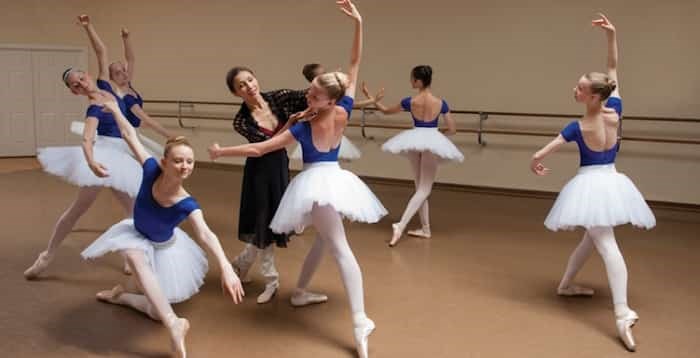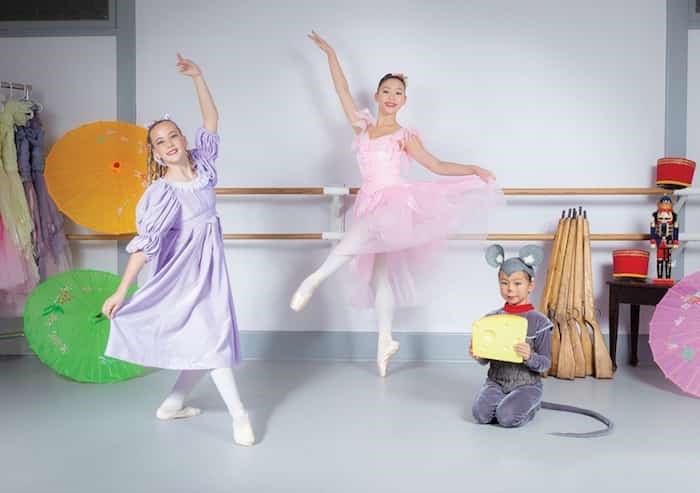 Goh Ballet Academy director Chan Han Goh instructs a young dancer in the nuance of movement. Goh is currently preparing for Goh Ballet’s 10th anniversary production of The Nutcracker at the Queen Elizabeth Theatre. photo supplied
Goh Ballet Academy director Chan Han Goh instructs a young dancer in the nuance of movement. Goh is currently preparing for Goh Ballet’s 10th anniversary production of The Nutcracker at the Queen Elizabeth Theatre. photo supplied
There was a time when she didn’t expect to hear that music ever again.
In fact, she hoped she wouldn’t.
As West �鶹��ýӳ��resident Chan Han Goh co-ordinates the intertwining spectacle and sentiment of this year’s staging of The Nutcracker at the Queen Elizabeth Theatre – a production that includes 250 actors, dancers, gymnasts; malevolent mice and whimsical unicorns – she recalls when she first became acquainted with the Sugar Plum Fairy.
As a 19-year-old newcomer to the National Ballet of Canada, Goh saw her name on the cast list for what would be her first major role in her first full-length ballet.
“It was unforgettable,” she says of playing the Sugar Plum Fairy.
 Dancers Tamara Ratkovic, Emma Ng, and Adelle Dosmagambetova glide through a recent dress rehearsal. The Nutcracker is a formative event for many young dancers, according to Goh Ballet director Chan Han Goh. – photo David Tresham
Dancers Tamara Ratkovic, Emma Ng, and Adelle Dosmagambetova glide through a recent dress rehearsal. The Nutcracker is a formative event for many young dancers, according to Goh Ballet director Chan Han Goh. – photo David Tresham
But it was also exhausting. While the ballet company might do eight performances of Swan Lake, they tended to do 30 performances of The Nutcracker.
“I probably thought at that point, when I retire, I don’t’ ever want to hear the Nutcracker music again,” she says with a laugh. “Every time I’d hear the Sugar Plum Fairy music – and they sometimes play it in restaurants – I’d lose my appetite because that’s a very difficult dance.”
It was Paris in the summer when he heard the heavens.
Pyotr Ilyich Tchaikovsky had just begun the task of finding the music that would turn the Nutcracker and the Mouse King – a children’s story published in 1816 – into a ballet.
The composer was on his way back to St. Petersburg after a stop in Carnegie Hall when he found himself in Paris, arrested by an instrument he’d never heard before.
It was the celeste, French for “heavenly.”
Invented only five years earlier, the keyboard instrument had a delicate sound, similar to a glockenspiel but soft, ethereal; perfect, Tchaikovsky realized, for the Sugar Plum Fairy.
The Nutcracker debuted in St. Petersburg in 1892, complete with marauding mice, a toy that acted as a passport to a magical, sugar-sparkling world, as well as perhaps the most beloved ballet music ever composed.
It was a dud.
“For the woman dancer there is very little in it, for art precisely nothing, and for the artistic fate of our ballet – it is yet one more step downwards,” wrote a critic of the day.
Even Tchaikovsky seemed to side with the critics.
“In spite of all the sumptuousness it did turn out to be rather boring,” he wrote in a letter to a friend. The great composer also dubbed what would become his signature masterpiece: “infinitely worse than Sleeping Beauty.”
But following that crucible of distaste and indifference, The Nutcracker saw a resurgence, in part because the story carried an appeal for one overlooked demographic: children.
On that St. Petersburg stage, one of the mice was played by George Balanchine. And while the ballet meant little to critics, it meant everything to Balanchine. It meant Christmas.
“For me Christmas was something extraordinary,” the dancer and choreographer Balanchine once told writer Solomon Volkov. “On Christmas night we had only the family at home: mother, auntie, and the children. And, of course, the Christmas tree.”
With a $25,000, 41-foot Christmas tree, Balanchine debuted The Nutcracker in New York in 1954 – 62 years after its underwhelming debut.
“Within a year it was a holiday blockbuster,” wrote Vanity Fair’s Laura Jacobs.
“If you’re going to pick an entry ballet we suggest you go to The Nutcracker,” remarks Goh. “For the students and for the dancers that participate, it’s a big part of their upbringing.”
Growing up in China in the 1970s, Goh has memories of seeing her parents flit and fly about the stage.
 Once the prima ballerina of the National Ballet of Canada, West Vancouver’s Chan Han Goh has dedicated herself to nurturing the talent of the next generation of dancers. – photo supplied
Once the prima ballerina of the National Ballet of Canada, West Vancouver’s Chan Han Goh has dedicated herself to nurturing the talent of the next generation of dancers. – photo supplied
“I watched so many performances,” she says. “My grandmother would always say that I’d be dancing in the aisles while the performers were dancing on stage.”
But she also remembers being forced to wait before she could officially walk up to the barre.
“They didn’t have private ballet schools,” she says. “It was all state-run ballet schools and the youngest age you could start was 10.”
But her training got a jumpstart when her family immigrated to Canada. Goh was eight years old and while she’d always loved to dance, movement took on a new importance in her life.
“I didn’t know a word of English when we immigrated,” she says, recalling the struggle to catch up to her classmates’ conversations through daily ESL classes. “I think I felt that dancing, that was something that was a constant. ... I didn’t need language skills when I was in dance class,” she says.
At 11 years old she sat down with her father and told him she wanted to train seriously.
“I actually didn’t have any inclination that I’d be a professional dancer at all. I just was in dance because I loved it.”
Following a colourful career including a stint as the prima ballerina for the National Ballet of Canada, Goh hung up her slippers in 2010 and tiptoed back to West Vancouver.
Her career has come full circle, she says, discussing her role mentoring young dancers and offering them different ways to express themselves through the training ground of Goh Ballet.
She says there’s a “huge difference” between being a dancer and her current role as a teacher and producer.
“When you’re dancing, it’s all about ‘me.’ And it should be. The focus is on the dancer,” she says. “You need to do what is best for you in order to deliver the best performance ... but if you’re the teacher or the producer it’s really never about you. It’s about everything else.”
In order to make this year’s rendition of The Nutcracker distinct, Goh plans to outfit the theatre lobby with decorations and set pieces.
Until the moment the lights go down in the theatre, Goh will be hard at work.
“My job is kind of done when the curtain goes up,” she says.
But when the curtain comes up she can relax, she says, and enjoy the music once more.


